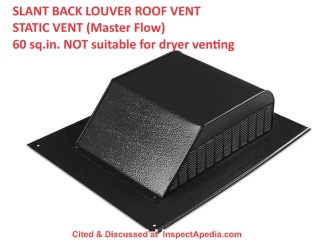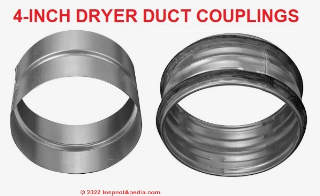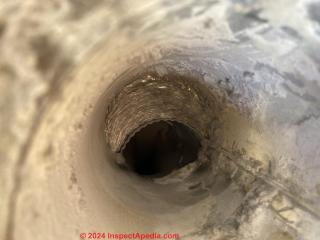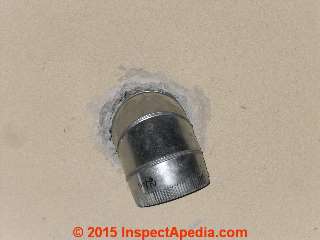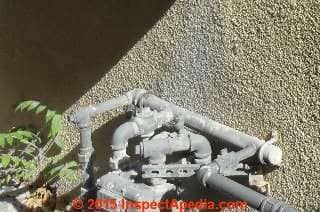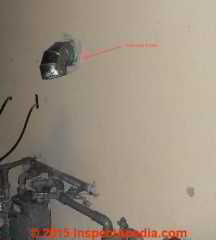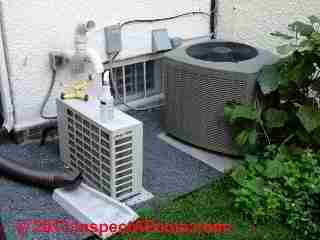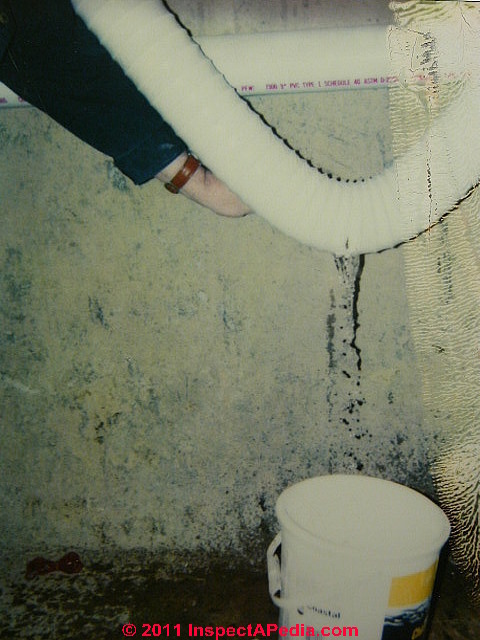 Clothes Dryer Exhaust Venting FAQs
Clothes Dryer Exhaust Venting FAQs
Which dryer vents work, which clog or are otherwise unsafe?
- POST a QUESTION or COMMENT about clothes dryer exhaust venting, ducting installation procedures, codes, standards
Clothes dryer exhaust vent & screening questions & answers:
Frequently-asked questions, FAQs, about clothes dryer venting: vent distances, terminations, location, routing, draft boosters, lint filters, fire safety, vent booster fans, vent length, diameter, materials, cleaning, and other dryer vent questions, answers, problems, solutions.
InspectAPedia tolerates no conflicts of interest. We have no relationship with advertisers, products, or services discussed at this website.
- Daniel Friedman, Publisher/Editor/Author - See WHO ARE WE?
Clothes Dryer Exhaust Vent FAQs
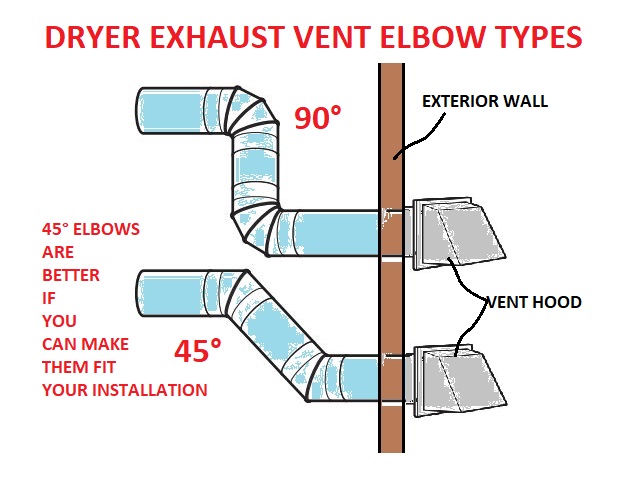 These questions and answers about how to vent a clothes dryer including fire codes, materials, routing, vent terminations, etc. were posted originally
These questions and answers about how to vent a clothes dryer including fire codes, materials, routing, vent terminations, etc. were posted originally
at CLOTHES DRYER VENTING - please see the guidance given there.
On 2024-07-12 by Steve - should a slant back louvre roof vent be used for a clothes dryer?
Can/Should a slant back louvre roof vent be used for a clothes dryer?
Our home was built that way but there is no way to clean the lint at the roof
Thank You
On 2024-07-12 by InspectApedia Publisher
@Steve,
Bottom line: No, you can not use a slant back louvered roof vent for venting a clothes dryer. It risks clogging and improper or even unsafe clothes dryer operation.
Details:
While indeed slant-back louvered roof vents such as the Master Flow unit I'll show here do, at least in some models, include a provision to connect the vent to a length of flex duct, those vents are NOT clothes dryer venting, and more generally, the vents are NOT designed for "forced" (fan-driven) ventilation.
Details about why this type of vent can't be used as a dryer exhaust vent cover:
1. The vent openings are small, close together, and will quickly clog with lint found in clothes dryer exhaust
2. There is no easy cleaning procedure to remove clogging lint: the vent is affixed to a roof surface and doesn't provide cleaning access nor can it be easily opened for cleaning
3. As the vent becomes lint-clogged it risks at the very least a longer, more-expensive clothes drying cycle time and in the worst case, a building fire if connected to an older clothes dryer that's not protected against overheating.
You'll see that manufacturers like Broan say, specifically, that this vent is Not suitable for a clothes dryer.
On 2022-10-24 by Kirk - how do I connect crimped ductwork for my dryer
I need to connect a coupler between 2 4 in crimped duct for my dryer what can I use.
On 2022-10-25 by InspectApedia (Editor)
@Kirk,
You can use either of the two types of 4-inch dryer duct connectors we show below. Ask for a "clothes dryer exhaust vent coupling".
Watch out: check the total effective vent duct length against the maximum allowed in your clothes dryer installation manual - to be sure your dryer will work economically and safely.
On 2022-05-27 by Jesse Lee - why does the dryer vent come out from the bottom of the dryer?
Is there a reason that dryer vents always come out of the dryer at the bottom instead of the top? Many of the problems with hooking up dryers to vent are due to the location of the vent (bottom of dryer).
On 2022-05-27 by InspectApedia-911 (mod)
@Jesse Lee,
My OPINON (which means I'm speculating) is that it's a common design feature - having to do with the location of the drum, motor, heater and other components that makes dryer exhausts vent at the bottom back or sides of the dryer.
To vent out of the dryer's top the appliance depth would have to be increased by the diameter of the vent.
On 2022-05-09 by Lynn
We had the dryer duct cleaned and the flow sensor on my dryer is still saying there is a blockage. When I disconnect it from the wall vent and run the dryer runs fine with no warning. There is a periscoping duct in the wall. Is it possible the air is not moving up quickly enough and causing the sensor to trigger?
On 2022-05-09 by Inspectapedia Com Moderator
@Lynn,
The periscope alone ought not be such a blockage that the dryer won't run.
Perhaps the duct cleaning damaged the duct or caused a collapse or blockage.
If you cannot physically see into the entire run of the duct, explore what you can from inside the home and from the outside outlet.
If you don't see a problem to be fixed and considering that the dryer runs normally when not connected to the duct, that suggests that you need to either get access to the whole duct to replace a section, or at least start by having the whole duct run inspected using a remote inspection camera such as those used by plumbing or well inspectors or chimney cleaning companies (Chimscan camera, for example.)
Let me know what you find.
On 2022-01-12 by Bea - Get rid of that rooftop lint filter.
My metal tube electric dryer vent is installed in a common wall and runs 20+ feet up to the exhaust vent on the steep pitched roof. Ugh. Worse, the vent filter drawer is at the exhaust vent...on the roof. I want install an in wall secondary trap in the laundry room wall where I can easily access and clean it. Good idea? If so, Good idea to also remove roof drawer?
On 2022-01-12 by Inspectapedia Com Moderator
@Bea,
Watch out: a lint filter located at the end of a clothes dryer vent is unsafe and even an illegal code violation in some jursidictions because of the increased risk of a vent blockage, dryer overheating, and a building fire. It's not just an inconvenience.
Get rid of that rooftop lint filter.
Clean and use the lint filter built into the dryer itself.
On 2021-11-11 by Brad - dryer vent connections are not aligned
My interior and exterior wall dryer vent connections do not completely align. See picture from outside house looking in through the vent. It's been like this for 15 years. Never clogged. Airflow seems good during use but clothes seem to take long time to dry. Electric dryer. Should this be fixed / redone to better alignment?
On 2021-11-11 by Inspectapedia Com Moderator
@Brad,
Arguing for fixing your dryer vent are leaks of moisture and lint into a building cavity inviting mold contamination
and less-likely but possible is the risk of blowing lint somewhere like into an electrical fixture where it becomes an overheat or fire risk.
Long drying time might be indicating that your dryer exhaust is blocked elsewhere in the system or at the outlet.On 2021-11-11 by Brad
@Inspectapedia Com Moderator, I reached in and can clearly feel all around the unseen section. There is a barrier/gasket of some sort that seals it from escaping into the wall. It did not have any lint build up of any kind. So I'm pretty confident the flow of moisture and lint is completely exiting. The path from dryer to wall exit is direct and inside/outside wall to wall. If you don't believe to airflow is compromised with that overlap then I'm assuming my old dryer is starting to simply fail. agree?
On 2021-11-11 by Inspectapedia Com Moderator
@Brad,
Good further steps,
No I don't assume the old dryer is "starting to fail"
In an electric dryer there are usually at least two electric heating elements.
If one has failed you will notice that the "high heat" setting on your dryer doesn't make the dryer any hotter than medium or low.
If all of the electric heating elements are working but it's taking longer to dry your clothes I suspect a problem with the venting, the air intake, or that the clothes entering the dryer are not as dry (wrung out by the washing machine's spin cycle) as usual.
See the various dryer inspection and maintenance articles listed under
CLOTHES DRYER VENTING - home
at the page end Recommended Articles list
On 2021-06-14 by Anonymous
If my dryer is vented on the back should the side vent panel be off as well. I'm thinking it should be covered because it seems to me it could start a fire.
On 2021-06-15 by inspectapedia.com.moderator (mod) - close off missing un-used dryer vent connection panel or port?
@Anonymous,
That's an interesting question and not one that I considered. Let's start by identifying the brand and model of your dryer and then we can take a look in the construction and installation manual to see what the manufacturer has to say about closing of unused exhaust vent openings in the dryer body.
On 2021-06-02 by Dino
Isn't the exhaust from a gas dryer a fire hazard with a propane tank only 3 inches away?
On 2021-06-02 by inspectapedia.com.moderator (mod) - exhaust from a gas dryer- fire hazard with a propane tank only 3 inches away?
@Dino,
The principal hazards of building vents close to LP tanks and reguators would be
- LP tank or its regulator vent too close to a building air INTAKE - such as combustion air to a heater, or breathing air to occupants;
- LP tank or its regulator or regulator vent too close to a potential source of ignitionWatch out: it's also a bad idea to let your garden hose spray up into the clothes dryer vent as you risk leaking water into the building wall cavity (causing costly and hidden mold contamination, rot, or inviting insect attack), and possibly damaging the dryer exhaust ducting.
On 2021-05-10 by Steve
Can a dryer vent go outside under the deck for 13 ft
On 2021-05-11 - by (mod) -
@Steve,
You will want to compare the total equivalent vent length including the effect of elbows or bends in the dryer vent piping when you match the installation that you want against the dryers manufacturer's instructions.
On 2021-04-30 by Anonymous
I have done that and I’m not getting anywhere even with Building Inspectors. I need to know if a back draft damper would do anything if it was put on my dryer in my apartment and if not how would I just disconnect it and cover the hole in the floor so her exhaust would not be able to get in .Thank you 🙏
On 2021-05-02 by (mod) - neighbors blowing the dryer exhaust into your living space
@Anonymous,
On the face of it it seems obvious there's a neighbors blowing the dryer exhaust into your living space that you were simply block it off and tell them that you were doing that.
Watch out! However what we are worried about is that you block a neighbors dryer exhaust and they have an old dryer that has a result overheats and search the building on fire. That's the reason I suggested that you report these things in writing as a fire and safety and mold hazard.
On 2021-04-30 by Anonymous
Complex of 4 neighbors dryer is venting into my dryer and apartment, how can I stop it ?
On 2021-04-30 - by (mod) -
@Anonymous,
If your neighbors' clothes dryer exhaust is actually entering your apartment or its structural cavities
then
You should notify your neighbors and also your landlord in writing of improper dryer venting that is both a fire hazard and risks potentially costly mold contamination.
On 2021-01-17 by janiceadele
we just moved into a condo, 12th floor of a 26 floor building. Our electric clothes dryer vents into a pipe (the stack). I use non perfume products but every once in a while the laundry room smells and it leaks into the main rooms like there is a back push of someone elses products. Th flexible connection seems fine with no cuts and no clogs. What next?
On 2021-01-18 by danjoefriedman (mod) - the laundry room smells and it leaks into the main rooms
We've seen this complaint before in multi-unit buildings and unfortunately it raised as a safety concern since it should never be the case that there's back pressure from other clothes dryers that backs out at yours.
Watch out: That sort of back pressure could cause your dryer to overheat which would be a fire hazard. Some of our readers have talked about installing a one-way check valve in the dryer vent system but you should not do that without first confirming with the manufacturer of your dryer that they consider such a move safe.
On 2020-10-17 by Eileen Perron - How do I attach my semi- rigid dryer duct at my wall opening with this strange setup?
Help! I purchased a new dryer. How do I attach my semi- rigid duct at my wall opening with this strange setup?
My old dryer was pushed up against this weird opening but now i see no way to attach duct for the new dryer?
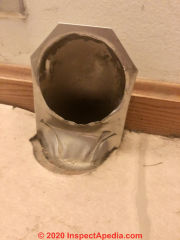
On 2020-10-17 by (mod)
You'll need a short section of metal dryer duct and a couple of clamps.
On 2020-10-17 by Eileen
I don’t see a lip to clamp the short section to! Also is the duct fitting inside the mouth of this piece? Last thing- does the semi rigid duct get attached to the threaded edge or to the smooth edge of smaller piece? Thank you!
On 2020-10-17 by (mod) - use male metal dryer exhaust vent section to connecto to existing outlet, + clamps
Right
The short section of metal clothes dryer exhaust vent will insert nto the fitting in your photo. Sometimes we need to slightly crimp the male metal exhaust duct to fit properly into the female vent connector, then adding metal tape or clamps to keep the vent assembly together.
Question: clothes dryer vent is too close to the back door of the laundry room
2019/11/07 Don:
I am trying to sell my house in CA. the city inspector says that the vent is too close to the back door of the laundry room. it's less then 3' from the door.
he calls it an "Enviroimental air duct".
I can't fin a definition of a "Enviroimental air duct" online. Also the dryer vent has been in that location since before we bought the home in 7/1998. it has the correct damper and size required. is this a retro fit requirement?
Reply:
I don't know what your inspector is citing either.
But take a look at CLOTHES DRYER VENT CLEARANCES & TERMINATION
I'm looking further but the codes and instructions at hand don't cite the concern raised by your inspector.
Keep in mind that the local code inspector is the final legal authority on such questions; their word is "law". So you need to either do what she wants or convince the inspector to change her mind - perhaps by politely citing authorities such as the IO manual for your dryer brand and model.
The California Clothes Dryer Vent Code paragraphs can be read
On 2019-05-26 by Bettie
Cane you vent a dryer out of the side of the dryer?
On 2019-05-28 by (mod) - some dryer models can vent through the side
Yes you can on some dryer models vent through the side. If your dryer is a model that can be vented through the side instead of the back you will see around knock out on one or both sides that's the same diameter as your dryer exhaust vent. Take a look and let me know what you see. Or post a photo of your dryer.
Also check the dryer manual as they will probably discuss the adoption there.
On 2018-05-31 by Margo
Hi,
I have discovered that modern dryers are deeper than I have room for. There is one dryer that will fit but there would only be 3 inches between the wall and the back of the dryer and that doesn't seem to be enough room for a 4 inch vent pipe.
I have not talked to an installer yet and I have not seen the back of the dryer. I believe the wall hole is about 2 inches to the right of where the dryer exhaust hole would line up. So I have two questions.
1. I doubt rigid 4 inch venting would work because I only have 3 inches of space. I don't think 4 inch semi-rigid would work either. I know it compresses length wise but the diameter would still be 4 inches so it seems like that would be a problem. Does anybody have any comments on that?
2. Does anybody have any opinions about a periscope dryer vent? That seems perfect for this application but I'm concerned because of potential restricted airflow and also because the dryer could not be moved without disrupting the connection to the wall vent. Of course we are only talking about 2 to 3 inches that the air has to move through the periscope vent so restricted airflow might not be a real problem.
Thanks for any suggestions!
On 2018-06-01 by (mod) - how to sqeeze in the dryer vent turns - Periscope dryer vent
Margo
Take a look at the special periscope type dryer vent adapters that handle the offset from dryer outlet to vent connector in tight spaces.
These are available from plumbing suppliers, building suppliers, and your local installers.
On 2018-02-14 by tom
dryer was vented to a patio area about 3' above the patio and a guest was burned badly when they came in contact with the metal covering over the vent- is their a code restriction or regulation that prohibits the venting of dryers onto areas meant for human activity or passage?
On 2018-02-14 by (mod) - burned from a clothes dryer exhaust vent
Tom
I'm certainly sorry that someone got burned from a clothes dryer exhaust vent at your patio. Take a look at this article on clothes dryer vent temperatures
DRYER & DRYER VENT TEMPERATURE MEASUREMENTS
you'll see that in a Typical and normally operating clothes dryer the highest temperature I could find anywhere was 143 degrees Fahrenheit inside the dryer during operation. Temperature at a dryer exhaust valve would be lower than that.
At that temperature brief .momentary contact with the dryer vent exhaust opening could not cause a significant burn to a person even in contact with bare skin.
Don't get me wrong I'm not arguing for a minute your report of someone getting burned isn't accurate.
Rather I'm expressing the concern that there is probably an improper and unsafe condition at this particular dryer, such as an obstructed or blocked vent line, or something else that's causing an abnormally high temperature. Those conditions risk of building fire and should be investigated immediately
here is an example datapoint illustrate what I mean. This is common data available in many Plumbing research articles such as those published by asse.
Immersing one's body part in hot water heated to 140 degrees for 2 seconds will cause a minor first degree burn.
Continued exposure for a total time of 5 Seconds at 140F could cause permanently damaging second degree scalding Burns.
Immersing one's hand entirely in hot water is of course far more severe than momentarily touching a hot surface.
When a person touches a hot surface their instinct is to withdraw that contact immediately.
So I would expect that the person on your patio who touched the dryer vent did not maintain continuous contact for 5 seconds and not even for 2 seconds.
Therefore it seems to me likely that the temperature at your dryer exhaust had to be considerably hotter than 140 degrees if the person suffered a serious burn.
That's the basis for my warning that your dryer is not operating properly nor safely. I'd certainly like to hear more details about this event and I'm glad to research further in your behalf.
Can you tell me the country and Province or state and city where this accident occurred? And can you tell me the clothes dryer brand and model and fuel or energy source? You can also use the picture frame icon to the right of a comment button to attach some photos.
On 2017-12-15 by wayne
what is used to join dryer vent pipe together
On 2017-12-16 by (mod) -
Wayne I use sections of metal vent pipe designed for that purpose.
If you're joining flex vent you can insert the downstream end over the outside of the upstream end and use duct tape. But safer, more-effective dryer vent ducts use solid metal, often aluminum.
See CLOTHES DRYER VENT DUCT MATERIALS at https://inspectapedia.com/ventilation/Clothes_Dryer_Vent_Installation.php#Material
If I have to cut a metal duct length shorter and then need to insert it into a mating duct section I use a crimping tool to reduce the duct outer diameter so that it fits neatly into the mate.
Watch out: Do not join sections with screws. Use metal foil tape. Screw tips protruding into the dryer exhaust vent increase the rate of lint clogging and can cause dryer overheating and a fire.
On 2017-11-06 by Bill Allerton
My Electric clothes dryer takes an excessive time to dry. I finally got under the house to inspect the ducting and I found it totally disconnected and just discharging into mid air into the crawl space. Would the ducting being disconnected cause excessive dryer run time to heat the clothes.
On 2017-11-07 by (mod) - clothes dryer takes an excessive time to dry.
It seems to be more likely that a blocked vent what would cause a dryer to take longer to dry clothes, assuming that it's heating component is working correctly. Beware that that's a serious fire hazard.
Of course it's a very bad idea to be dumping dryer exhaust into a crawl space for other reasons such as the problem of trapping moisture and causing mold contamination
On 2017-04-01 by Domenic
Can I extend the dryer vent on the outside, is that allowable ? I got a notice that my Dryer vent was to close to my furnace exhaust- ( moisture-exhaust duct shall not terminate within 3 ft (1 m) in any direction of any pressure regulator vent termination or fresh-air intake) . I can do it from the inside,so I was thinking to have it extend the exhaust pipe extend 18 inches along the wall the opposite direction of the Fresh intake pipe.
side the side wall.
On 2017-04-01 by (mod) - Can I extend the dryer vent on the outside,
Dom
It's a perfectly fair question that you ask but I'm not sure the answer. I think I would ask the local building inspector what they will accept. An example concern would be living in a freezing climate and the risk of condensate freezing in the dryer vent during winter.If you can make the extension on the building interior that would be a better approach. Make sure that the total dryer vent legs doesn't exceed what the manufacturer allows. Don't forget the equivalent length includes the effects of nineties or elbows or bends in the line
On 2016-04-24 by Beverly
I need to know what is considered a 90 degree turn for dryer venting. I believe that you are supposed to subtract 5 feet off the total acceptable length for each 90 degree turn.
I will be using the rigid metal vent material up a wall, (using two 90 degree pieces for the turns at the top) continuing the rigid metal vent material across a drop ceiling and down a wall to an outside dryer vent flap.
Do you count the 90 degree piece that’s directly off the back of the dryer?
Do you also include the 90 degree piece that is connected to an approximately 10” metal vent that goes outside and is connected to the dryer vent flap? So do I have 2, 3, or 4 90 degree turns?
On 2016-03-28 by (mod) - what counts as an elbow in dryer venting?
Beverly, every 90 degree turn counts - after all, the air does have to go through each.
On 2016-03-28 by Donna w
Can a dryer be vented from an interior room i.e. Where vent travels between ceiling and drywall out to exterior wall?
On 2016-03-28 by (mod) - Can a dryer be vented from an interior room i.e.
Yes, subject to length and bend restrictions discussed above.
On 2016-03-24 by Kelly
Just a note, screws should never be used in dryer vents, they protrude into the vent system and quickly add to lint gathering in the pipe. Use only metal foil tape to hold the pipe and secure every 4' with strapping or hangers for support.
On 2016-03-26 by (mod) - screws should never be used in dryer vents
Agree completely, Kelly; we emphasize that in the article series above.
On 2016-03-23 by Noah
My electric dryer vent, after around 30' of mostly rigid straight pipe, terminates to the outside through a downward facing vent that has at least 2' of space below (before the ground) and likely a reasonable amount of air flow otherwise from left to right. Should I be concerned here? Any reason I absolutely need outside access? Anything I should do?
On 2016-03-23 by (mod) - dryer vent installation height
Noah
your installation height sound reasonably good to me, though in areas of deep snow or if exposed to freezing there could be a safety worry if th vent can become blocked by snow or ice or frozen condenste.
That 30 feet is a long run, perhaps longer than the dryer manufacturer recommends. I'd check for soot clogging in the system from time to time. If you notice clothes taking longer to dry or the dryer running extra hot those are signs of dangerous dryer vent blocking.
ALL READERS
Use the "Click to Show or Hide FAQs" link just above to see recently-posted questions, comments where you'll be referred to a separate article with diagnostic questions & answers about dryer venting.
Question: dryer vent that is easy to clean but keeps animals out
Aug 15, 2014) Karen said:
This is a very helpful article. Can you please recommend an exterior animal proof cover that can be easily cleaned?
[Click to enlarge any image]
These questions & replies were posted originally
at CLOTHES DRYER VENTING - home page for this topic.
Reply:
Karen, the self-closing horizontal louvered dryer vent covers have done a pretty good job of keeping animals out of the vents I've inspected.
Above in this article we show another type - see this image - inspectapedia.com/interiors/Dryer_Vent_Lambro_023.jpg
that might work for you.
Those seem to work well against birds and rodents.
If you've got a different animal problem let me know.
DO NOT put a screen over the dryer vent. The screens clog with lint creating a fire hazard.
Question: distance from dryer vent to A/C or heat pump condenser unit
(May 10, 2015) Ryan said:
Is there any minimum distance standard that a dryer vent should terminate away from a A/C condenser?
My neighbors dryer vent terminates about a foot away from his condenser. It seems to me that this could allow lint to blow all over the fins of the condenser reducing efficiency and possibly shorten the life of the condenser. Any idea? Thanks.
Reply:
Ryan
Clearance distances for air conditioners are given at
inspectapedia.com/aircond/HVAC_Clearance_Distances.php
I haven't found a code citation specifically addressing clothes dryer clearance to AC unit condensers but that topic is discussed in the article I cite above.
I agree that regardless of distance, if lint is clogging the condenser fins that's going to be a problem. There also *might* be a problem from hot air exiting close to the condenser too.
Question: why does the dryer vent get so hot
(July 25, 2015) Hope said:
We replaced all of our dryer duct work today. Used 4 inch solid duct to outside wall. When we turn the dryer on the duct work becomes so hot. Almost to the point that you can not touch it. Can you please suggest what may be causing this. The dry is about 7 years old and has a new heating element as of 2014.
Thank you!
Reply: clothes dryer house fire statistics
Hope:
Watch out: you could be facing a fire hazard from an overheated clothes dryer that can set lint or clothing on fire. Flynn (2008) found that in nursing homes she studied, clothes dryers or washers were involved in 12% of the fires - more than double the number of fires ascribed to heating equipment.
A more broadly based Canadian study (Wijayasinghe 2011) found that overall 4% of house fires were traced to clothes dryers.
Typically I see hot dryer exhaust when the dryer air circulating-intake lint screen is clogged; or if you've pulled the lint filter on your dryer and cleaned it you may need to look for and vacuum out additional lint that leaked around the lint screen and that is blocking the dryer's air flow.
A second cause of hot dryer exhaust might be a blocked dryer outlet vent or clogging anywhere in the length of the dryer vent ducting.
Question: reader promotes a pest resistant dryer vent
6 August 2015 Kelly said:
I am confused, in the above captions one place it says Watch out: do not eave off the dryer wall vent rodent screen: And lower down with the same picture it says.
DO NOT PUT A SCREEN that will block or collect lint on the exterior of a clothes dryer vent as you may cause dryer overheating and a fire.
Example: the 2009 International Mechanical code 504.4 says -
Dryer exhaust ducts for cloths dryers shall terminate on the outside of the building and shall be equipped with a backdraft damper. Screens shall not be installed at the duct termination.
The only product I found to comply with this and keep pest out is the No Pest Vent. We put them on our dryer and bathroom vent fans, no more birds, mice, bees, etc and our laundry and bathrooms are warmer in the winter because it has two doors the close that keeps the backdrafts out. Actually our drying time is less as well because it flows air better. I would recommend this product for anyone having pest problems or simply for the efficiency and energy savings.
Reply: don't confuse dryer vent louvers or flapper opening doors that keep rodents or birds out of a dryer vent system with an external screen that traps lint and forms a fire hazard
Kelly:
We want what Timm (1983) pointed out (as have others) a dryer vent that lets moist warm air vent out, doesn't invite pests in, and doesn't clog with lint. That is we want to assure:
- rodents or birds to be unable to enter the dryer vent; most dryer vents have an air-flow-operated flapper or louvered opening that swings open when the dryer is operating, thus allowing dryer exhaust to blow out of the building; when the dryer stops the vent closes and uninvited pests are kept out.
- Some clothes dryer vents include an additional screen over the vent opening that is intended to improve the resistance of the vent to entry by rodents or birds.
Those screens can become lint clogged and block the vent, causing a fire.Since pests are not likely to try to enter a dryer vent when the dryer is actually operating, you want to be sure that when the dryer stops the vent closes fully - whether it's a single flapper door OR a multiple-louvered vent covering. I have found that BOTH types of doors can become clogged with lint and may then fail to close fully.
A third type of dryer vent uses a sliding plastic "can" structure that lifts up to vent when the dryer runs and closes positively when off. That
The No Pest Vent people, whom I suspect you represent, sent me an email today advertising their product.
At the end of the day, you want a dryer vent that keeps pests out but doesn't trap lint and cause a fire. While the product you cite may be a fine one, there are dozens of dryer vents on the market that open to let moist dryer vent air out when the dryer is running and close adequately to keep animals out when the dryer is off.
That's what is called for by typical clothes dryer installation instructions. The product you name is not a requirement. Your comments are perhaps a bit of an advertisement.
Watch out: in our experience all of the clothes dryer vent openings, flappers, louvers or air-operated opening and closing dryer vents that we have installed or inspected need periodic inspection and occasional cleaning for safe, effective operation.
Question: move our dryer to the garage from the inside of the home
(Oct 26, 2015) JR said:
I'd like to move our dryer to the garage from the inside of the home.
Ventilating would be better suited as it would be a horizontal exhaust as compared to the current vertical one we have now.
My question is can the exhaust pipes be exposed to the garage or does it have to be behind drywall? I live in California so does it require certain building codes for dryer vents? Thank you
Reply: California clothes dryer vent code citations
I'd ask your local building department about local codes. Dryer vents should terminate outside of the building (not in the garage).
In general clothes dryer vents do not have to be enclosed in building walls. Be sure to check the dryer vent lengths and also the number of bends or elbows in the vent system against what your dryer manufacturer agrees is safe. In California (USA) the ventilation requirements for clothes dryers are specified by the following:
California” Uniform Mechanical Code. Sections 504.1 and 504.3. Section 504.3.1
Section 504.3.1 Dryer venting shall terminate on the exterior of the building and will have a back draft damper (flapper). Screens shall not be permitted or installed at the dryer vent termination. Clothes dryer vent pipes shall not pass through or extend into other ducting or plenums.
Dryer ducting shall not be fastened with screw type fasteners which may impede the air flow or catch lint, yet must be fastened and sealed “substantially airtight” at each joint. (An approved fastening system is aluminum duct tape)
Section 504.3.2 A minimum of a 4-inch diameter duct is required.
Section 504.3.2.1 Clothes dryer vent ducts shall be metal and shall have a smooth interior surface.
An approved “flexible duct connector” of not more than 6 feet in length may be used to connect the dryer to the dryer vent pipe.
“Flexible duct connectors shall not be concealed within the construction.” (Flex duct connectors shall not pass into or through a concealed space. This includes cabinets, walls and attic spaces).
Section 504.3.2.2 A dryer vent duct shall not exceed the maximum length (horizontal and/or vertical) of 14 feet including two (90-degree) turns without a mechanical upgrade. Two feet of length shall be deducted for each additional 90-degree turn.
Question: installing a dryer vent in the second floor
(Nov 23, 2015) Kevin said:
I am installing a dryer vent in the second floor with a very short horizontal run.
My concern is if there is an issue with the distance from the vent exhaust to the second floor roof. I live in the mid-west an we get cold weather and snow. I am concerned about causing an ice dam at the fascia and gutter area. It would be approximately 12-18" above the shingles
Reply:
I don't quite have the picture - you can use our page bottom CONTACT link to send me a sketch.
If you mean you're venting vertically up through the roof, the heat from the exhaust will certainly melt snow that is blown down-upon from the vent, and worse, if there is a deep snow cover and freeze/thaw the vent could freeze shut and cause a dryer fire.
If you're venting out through a side wall, gable end or soffit, insulation of the dryer vent ducting may do the job.
Question: safe to vent almost directly to the outside?
(Dec 3, 2015) Anonymous said:
is it safe to vent almost directly to the outside (opening to outside located just above floor and dryer vent at same level
Reply:
Anon
I'm not sure I understand the question correctly. But if you are asking if very short dryer vent distances from dryer to the building exterior are safe - sure as long as the other requirements specified by the manufacturer for venting are met such as venting material, connections, routing. Shorter vents mean less risk of clogging.
Clothes Dryer Vent Termination Clearance Distances
An InspectApedia.com reader provided this pair of photographs of a clothes dryer exhaust vent termination on the building's exterior wall. Above we see that there is no proper cover on this dryer vent: birds, rodents, or someone else can enter the dryer vent, nest therein, block up the dryer vent, and cause a dryer fire or a building fire.
Below we see more trouble with this ugly dryer vent installation:
The clothes dryer vent, located about 20" above the outdoor gas meter is blowing lint all over the gas meter and its various parts.
This might seem harmless but it's not. Lint blockage of the vent port on a gas regulator valve can cause a dangerous gas leak inside the building risking a fire or explosion.
I haven't found an explicit model building code giving a minimum clearance distance from a dryer exhaust vent opening to a gas meter (or to the meter's regulator).
The minimum distance of three feet clearance from the gas meter to the clothes dryer intake or exhaust vent opening is given by the article cited below. You'll see the three-foot rule commonly cited by gas company specifications such as our second citation just below.
- See GAS METER CODES & CLEARANCE DISTANCES
- Puget Sound Energy, Inc., "Gas Meter Clearances and Service Installation Requirements(March 2016)", [PDF] new retrieval, 3/26/2016, original source: https://pse.com/accountsandservices/Construction/Documents/3885.pdf
Question: how far a wall mounted dryer should be from the ceiling
(Dec 28, 2015) Anonymous said:
Is there a law/guideline how far a wall mounted dryer should be from the ceiling
Reply:
Anon:
Check the installation instructions for your clothes dryer - the manufacturer will give the necessary clearance distances.
Common sense will also tell us that the dryer opening and controls have to be readily accessible by a user standing on the floor.
Question: is 24" clearance from dryer vent to ground safe for a 30 foot dryer vent run?
Noah said:
My electric dryer vent, after around 30' of mostly rigid straight pipe, terminates to the outside through a downward facing vent that has at least 2' of space below (before the ground) and likely a reasonable amount of air flow otherwise from left to right. Should I be concerned here? Any reason I absolutely need outside access? Anything I should do?
Reply:
Noah your installation height sound reasonably good to me, though in areas of deep snow or if exposed to freezing there could be a safety worry if the vent can become blocked by snow or ice or frozen condensate.
That 30 feet is a long run, perhaps longer than the dryer manufacturer recommends. I'd check for soot clogging in the system from time to time. If you notice clothes taking longer to dry or the dryer running extra hot those are signs of dangerous dryer vent blocking.
Question: dryer vent clearance to other mechanical systems: air conditioners, motors, heating equipment, air intakes
2016/03/24 Stephanie said:
What is the required distance between a through the outside wall direct furnace vent and a dryer vent.
I'm renting and they are very close together.
I tried to find the requirements myself but was unsuccessful.
Thank you so much
This question appeared originally at INDOOR AIR QUALITY IMPROVEMENT GUIDE
Reply:
Stephanie: if the direct vent furnace air intake can pull in lint from the clothes dryer the installation is unsafe. Lint clogging the direct-vented furnace could result in vent overheating and possibly a building fire. But that's a subjective opinion on my part as I have not seen an explicit clearance distance stated in model building codes nor installation instructions.
at DIRECT VENTS / SIDE WALL VENTS we find a more general clearance specifications that in my view serve as a reasonable model-answer to your question. I quote:
- The exhaust vent terminal shall be located at least 3-feet above any forced air inlet located within 10-feet.
See [the figure in the original article cited above] for a depiction [courtesy of Thermo Pride] of the minimum required clearances between vent terminations and building features according to the National Fuel Gas Code (NFGC).[19]This article and thus my suggested specification (10 feet) recognizes that dryer lint can clog a key vent such as on a gas regulator at a distance of 4 feet nd that a significantly greater distance would be needed for safe clearance between a clothes dryer vent outlet and the air inlet of any mechanical system such as a direct vent chimney sidewall or rooftop penetration. That's a reasonable minimum distance of 10 feet.
The local building code official is the final authority on questions like this, particularly as there may be site conditions that for safety should change general safe clearance distance recommendations.
at A/C CLEARANCES from OTHER MECHANICALS where we discuss distances from a dryer vent to an air conditioner compressor, we include the following:
In our photo above, from a Minneapolis MN home, these two compressor/condenser units are just about three feet apart - a little close, and that right-most larger compressor/condenser unit is too close to building walls, a clothes dryer vent, and shrubbery.
We also see that direct-vented heating appliance white PVC piping is blowing exhaust close to these units. The installation is nice-looking and neat though.
- Clothes dryer vent outlet:
Do not locate a compressor/condenser unit where the clothes dryer vent will blow onto or close to the unit. Lint-clogging of the compressor/condenser's condensing coils is likely to be a problem and the extra warm air won't help the cooling cycle efficiency or equipment life. Move the equipment or move the dryer vent.- Heating appliance direct vent outlet: Do not locate the outdoor HVAC compressor/condenser unit where exhaust from a direct-vented heating appliance will blow onto the unit.
...
Continue reading at CLOTHES DRYER VENTING - topic home, or select a topic from the closely-related articles below, or see the complete ARTICLE INDEX.
Or see CLOTHES DRYER VENTING FAQs-2 - more-recent questions and answers about venting clothes dryers
Or see this
Article Series
- CLOTHES DRYER INSTALLATION & REPAIR - home
- CLOTHES DRYER ASBESTOS
- CLOTHES DRYER FIRE HAZARD WARNINGS
- CLOTHES DRYER FIRE RESEARCH
- CLOTHES DRYER SAFETY CHECKLIST
- CLOTHES DRYER TEMPERATURES
- CLOTHES DRYER VENTING - home
Suggested citation for this web page
CLOTHES DRYER VENTING FAQs at InspectApedia.com - online encyclopedia of building & environmental inspection, testing, diagnosis, repair, & problem prevention advice.
Or see this
INDEX to RELATED ARTICLES: ARTICLE INDEX to APPLIANCE REPAIR
Or use the SEARCH BOX found below to Ask a Question or Search InspectApedia
Ask a Question or Search InspectApedia
Try the search box just below, or if you prefer, post a question or comment in the Comments box below and we will respond promptly.
Search the InspectApedia website
Note: appearance of your Comment below may be delayed: if your comment contains an image, photograph, web link, or text that looks to the software as if it might be a web link, your posting will appear after it has been approved by a moderator. Apologies for the delay.
Only one image can be added per comment but you can post as many comments, and therefore images, as you like.
You will not receive a notification when a response to your question has been posted.
Please bookmark this page to make it easy for you to check back for our response.
IF above you see "Comment Form is loading comments..." then COMMENT BOX - countable.ca / bawkbox.com IS NOT WORKING.
In any case you are welcome to send an email directly to us at InspectApedia.com at editor@inspectApedia.com
We'll reply to you directly. Please help us help you by noting, in your email, the URL of the InspectApedia page where you wanted to comment.
Citations & References
In addition to any citations in the article above, a full list is available on request.
- John Cranor [Website: /www.house-whisperer.com ] , ASHI certified home inspector (house-whisperer.com) in Richmond, VA, can be reached by email to: johncranor@verizon.net or by telephone at 804-873-8534. Technical review, email, 1/2012
- [8] "The Facts About Clothes Dryer Exhaust Systems", John Cranor, the ASHI Reporter, April 2005,American Society of Home Inspectors,® Inc., 932 Lee Street, Suite 101, Des Plaines, Illinois, 60016, Tel: 847-759-2820, website: ashi.org, original source: ashireporter.org/articles/articles.aspx?id=161
- In addition to citations & references found in this article, see the research citations given at the end of the related articles found at our suggested
CONTINUE READING or RECOMMENDED ARTICLES.
- Carson, Dunlop & Associates Ltd., 120 Carlton Street Suite 407, Toronto ON M5A 4K2. Tel: (416) 964-9415 1-800-268-7070 Email: info@carsondunlop.com. Alan Carson is a past president of ASHI, the American Society of Home Inspectors.
Thanks to Alan Carson and Bob Dunlop, for permission for InspectAPedia to use text excerpts from The HOME REFERENCE BOOK - the Encyclopedia of Homes and to use illustrations from The ILLUSTRATED HOME .
Carson Dunlop Associates provides extensive home inspection education and report writing material. In gratitude we provide links to tsome Carson Dunlop Associates products and services.


